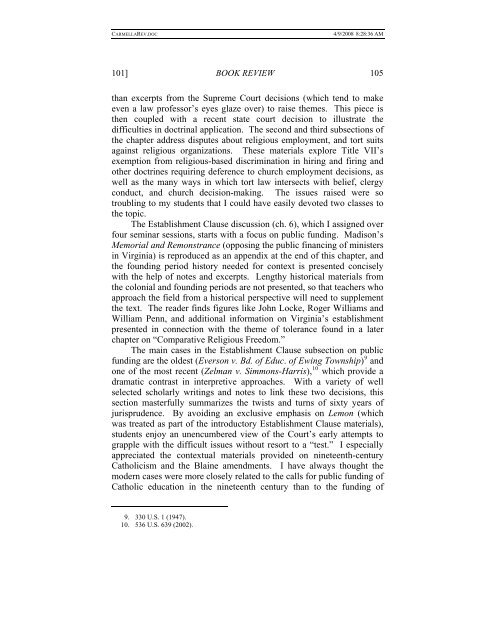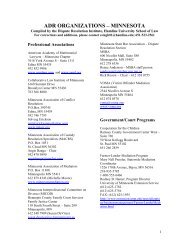LAW AND RELIGION: CASES AND MATERIALS - Hamline Law
LAW AND RELIGION: CASES AND MATERIALS - Hamline Law
LAW AND RELIGION: CASES AND MATERIALS - Hamline Law
You also want an ePaper? Increase the reach of your titles
YUMPU automatically turns print PDFs into web optimized ePapers that Google loves.
CARMELLAREV.DOC 4/9/2008 8:28:36 AM<br />
101] BOOK REVIEW 105<br />
than excerpts from the Supreme Court decisions (which tend to make<br />
even a law professor’s eyes glaze over) to raise themes. This piece is<br />
then coupled with a recent state court decision to illustrate the<br />
difficulties in doctrinal application. The second and third subsections of<br />
the chapter address disputes about religious employment, and tort suits<br />
against religious organizations. These materials explore Title VII’s<br />
exemption from religious-based discrimination in hiring and firing and<br />
other doctrines requiring deference to church employment decisions, as<br />
well as the many ways in which tort law intersects with belief, clergy<br />
conduct, and church decision-making. The issues raised were so<br />
troubling to my students that I could have easily devoted two classes to<br />
the topic.<br />
The Establishment Clause discussion (ch. 6), which I assigned over<br />
four seminar sessions, starts with a focus on public funding. Madison’s<br />
Memorial and Remonstrance (opposing the public financing of ministers<br />
in Virginia) is reproduced as an appendix at the end of this chapter, and<br />
the founding period history needed for context is presented concisely<br />
with the help of notes and excerpts. Lengthy historical materials from<br />
the colonial and founding periods are not presented, so that teachers who<br />
approach the field from a historical perspective will need to supplement<br />
the text. The reader finds figures like John Locke, Roger Williams and<br />
William Penn, and additional information on Virginia’s establishment<br />
presented in connection with the theme of tolerance found in a later<br />
chapter on “Comparative Religious Freedom.”<br />
The main cases in the Establishment Clause subsection on public<br />
funding are the oldest (Everson v. Bd. of Educ. of Ewing Township) 9 and<br />
one of the most recent (Zelman v. Simmons-Harris), 10 which provide a<br />
dramatic contrast in interpretive approaches. With a variety of well<br />
selected scholarly writings and notes to link these two decisions, this<br />
section masterfully summarizes the twists and turns of sixty years of<br />
jurisprudence. By avoiding an exclusive emphasis on Lemon (which<br />
was treated as part of the introductory Establishment Clause materials),<br />
students enjoy an unencumbered view of the Court’s early attempts to<br />
grapple with the difficult issues without resort to a “test.” I especially<br />
appreciated the contextual materials provided on nineteenth-century<br />
Catholicism and the Blaine amendments. I have always thought the<br />
modern cases were more closely related to the calls for public funding of<br />
Catholic education in the nineteenth century than to the funding of<br />
9. 330 U.S. 1 (1947).<br />
10. 536 U.S. 639 (2002).
















